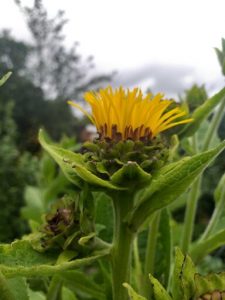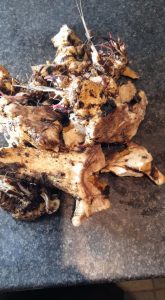Deep Winter Roots for Help with Respiratory Infections

Moving round the seasonal wheel and continuing from her previous article, ‘Late Autumn Medicines’, Medical Herbalist Edwina Hodkinson shares how we can develop our Swynwraig skills and practices, this time focusing on some healing roots of our land.
Cerridwen, The Swynwraig or wise woman walks among the copper blanket of fallen autumn leaves. The trees are almost bare as the late afternoon darkens to night much earlier and the land cools. All around her all that remains of the plants and flowers are dead stalks and the last remnants of seeds scattered on the earth awaiting spring. The Swynwraig knows that in late autumn life returns to the soil, to sleep over winter and the most valuable medicines are now hidden beneath the soil. As with humans, there is deep healing too in the stillness of the dark half of the year.
Honouring the plants, she takes her trowel and digs deep into the soil to expose gnarled, black roots. Cutting off a chunk, she checks its identity by how it looks, its smell and by how it feels. She has memorised the location of the plants from summer but now the aerial parts have died back she needs to make double sure that she has the correct roots. It’s so easy to get it wrong. Her hands are dark with the soil, her fingernails dirty and she takes only what she needs, placing it carefully in her basket. She thanks the plant, taking care to leave some of it behind for next season’s growth.
Back in her kitchen she scrubs, rinses, peels and chops the plants. Many of the roots are very aromatic, a reminder of the potency the volatile oils have when healing our body, and which makes them ideal for her medicine making.
Elecampane
Elecampane Inula helenium is her favourite root to dig. The tall raggedy sunflower heads of summer have died down and the roots are thick and gnarled. There are shoots for next year’s growth that she cuts off ready to replant, knowing in a few years there will be another large Elecampane plant growing somewhere else. The aroma reaches her nostrils as her knife pares away the skin to pale roots and she tastes a little piece. It’s aromatic at first and then the bitterness strikes her and her tongue tingles.
Elecampane is a great chest medicine, and reaches deep into the lungs to treat those thick, wet, infected coughs, helping to bring up the green phlegm that gets stuck and is hard to reach and cough up. Its warming, antibacterial action, eases and soothes coughs. It has been used to treat TB in the past. She would never use it for dry coughs; there are other slippery, soothing roots for that and Elecampane is too drying. She loves it too for its bitterness which is great medicine for the digestive tract, encouraging appetite and promoting digestive action when it feels sluggish. Those lovely essential oils have a relaxing action on the gut, easing cramps and the inulin is great for feeding healthy gut bacteria so vital for gut health.
Angelica Root
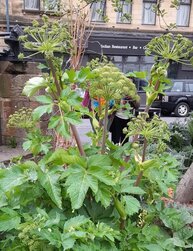 There is Angelica root in her basket too, dark and pungent. The Swynwraig grows this in her garden and harvests the roots after the first year of growth before, on its second year of growth, it reaches to the sky with its green globes of flowers. This is a sacred herb from the cold lands. Its Latin name of Angelica archangelica is a clear indication there is more to this herb than meets the eye. It’s a herb of the angels which is good for protection and connecting to the upper worlds. Angelica is used in sweat lodges and in saunas to help with dreaming, connecting to spirit and to facilitate shamanic work.
There is Angelica root in her basket too, dark and pungent. The Swynwraig grows this in her garden and harvests the roots after the first year of growth before, on its second year of growth, it reaches to the sky with its green globes of flowers. This is a sacred herb from the cold lands. Its Latin name of Angelica archangelica is a clear indication there is more to this herb than meets the eye. It’s a herb of the angels which is good for protection and connecting to the upper worlds. Angelica is used in sweat lodges and in saunas to help with dreaming, connecting to spirit and to facilitate shamanic work.
It’s a herb that the Swynwraig wants to use in all her winter medicines, as, like Elecampane, it reaches deep into the lungs, helping the coughing up of stuck infected phlegm, as it nourishes lung tissue and increases the circulation in the lungs. She often chews a piece of root at the first sign of a cold to boost her immunity, help decongest her nose and ease her sore throat. Angelica is good digestive medicine too with its bitter action and can help clear her head and improve her concentration. What she really likes about it, is its ability to support and nourish the adrenal glands and clear the head, something she finds useful when supporting people with fatigue.
In this video I am digging up Elecampane and Marshmallow Root for the next day’s medicines – all part of making the magic happen…
Horseradish Root
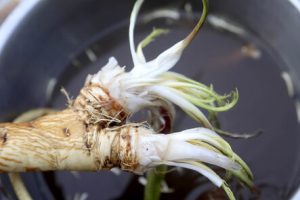 The Swynwraig is glad she can make use of the horseradish root. It’s quite an invasive plant and she had to take care when planting it in her garden. It’s another hot and drying root that is very useful this time of the year, so useful in this cold damp climate of ours, here in the UK. Chopping the fresh root she feels its power in clearing her sinuses and chest. She loves to taste a little, enjoying its fiery blast in her nostrils and warmth in her belly. She knows how good this pungent herb is in a fire cider vinegar alongside other hot anti-viral herbs such as ginger, garlic, chilli and cinnamon. Horseradish is a great antibacterial herb for congested sinuses, colds, and improving circulation.
The Swynwraig is glad she can make use of the horseradish root. It’s quite an invasive plant and she had to take care when planting it in her garden. It’s another hot and drying root that is very useful this time of the year, so useful in this cold damp climate of ours, here in the UK. Chopping the fresh root she feels its power in clearing her sinuses and chest. She loves to taste a little, enjoying its fiery blast in her nostrils and warmth in her belly. She knows how good this pungent herb is in a fire cider vinegar alongside other hot anti-viral herbs such as ginger, garlic, chilli and cinnamon. Horseradish is a great antibacterial herb for congested sinuses, colds, and improving circulation.
Fire Cider Vinegar Recipe
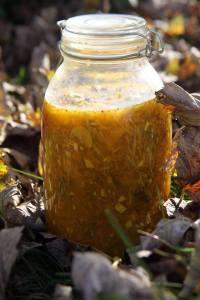 Fire cider vinegar is a great and very simple medicine and powerful winter tonic using easily accessible kitchen ingredients with other herbs added for extra potency. It’s amazing for colds, viruses, coughs and improving circulation and can put a bit of fire in the belly. The Swynwraig understands that this medicine can be made as a community, forging deep roots and strengthening bonds and connection as medicines are made together and shared out afterwards.
Fire cider vinegar is a great and very simple medicine and powerful winter tonic using easily accessible kitchen ingredients with other herbs added for extra potency. It’s amazing for colds, viruses, coughs and improving circulation and can put a bit of fire in the belly. The Swynwraig understands that this medicine can be made as a community, forging deep roots and strengthening bonds and connection as medicines are made together and shared out afterwards.
Ingredients:
The exact ingredients aren’t too important, use whatever you can get hold of, in whatever amounts.
Key ingredients: Organic cider vinegar, Chillies, Garlic, Ginger, onion, horseradish
Optional ingredients: Sage, rosemary, thyme, elecampane, lungwort, nasturtium seeds, angelica.
Method:
- Wash or scrub and chop your fresh herbs and spices to prepare them. Place into the largest jar you have got. Add your dried herbs.
- Cover in cider vinegar.
- Shake well, ensuring all plant material is submerged.
- Keep somewhere cool and dry that you pass often so you will remember to shake the jar regularly.
- After a month or so, strain out the herbs, press or squeeze the herbs to get the most out of the product.
- Bottle and label. Take 15 ml daily as a winter tonic. Try it with a splash of hot water to make a lovely warming drink. If you get a cold or the flu you can up the dose and take it several times a day.
Edwina
Bury, Lancashire UK

Edwina Hodkinson. BSc (Hons) MNIMH – Medical Herbalist and trainee priestess of Cerridwen
I have been a medical herbalist for 12 years, having graduated with a first-class degree in Herbal Medicine at Central Lancashire University. I work as a consulting medical herbalist in private practice in Bolton, specialising in women’s health as well as working with community groups to help reconnect them to nature and the medicines growing around us. I have a love for our native wild medicines and like to work with them as much as possible which includes teaching local people about local herbs in a way that helps them reconnect to the world around them in a deeper way.
I have a background in nursing as well as having been a complementary therapist for over 25 years specialising in cancer care and working with the very sick. I am a forager, Clinical Reflexologist for 26 years, aromatherapist, Shamanic practitioner and Breath work coach.
websites: edwinahodkinsonherbalist.co.uk and weedsandwildmedicine.co.uk
Images by Edwina
Medical Disclaimer
This article is written for your interest and is not prescriptive for any medical complaint the reader may have. It is recommended for any health problems that you see an appropriate health care professional. If you want to take any herbs or make any remedies with them, you do this at your own risk and the author takes no responsibility.
